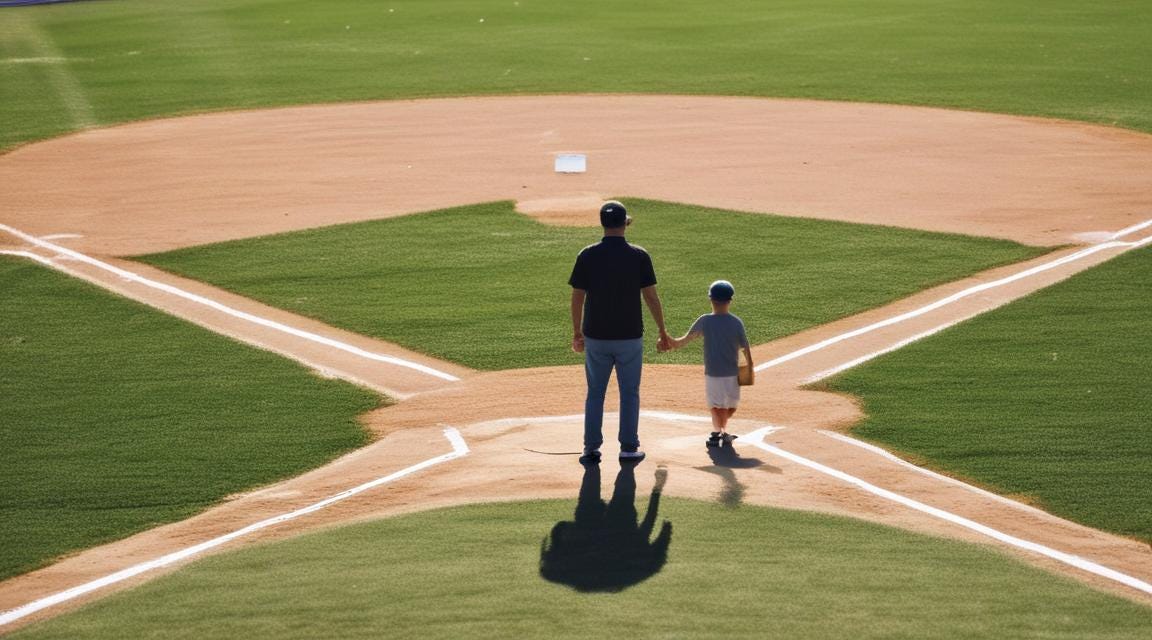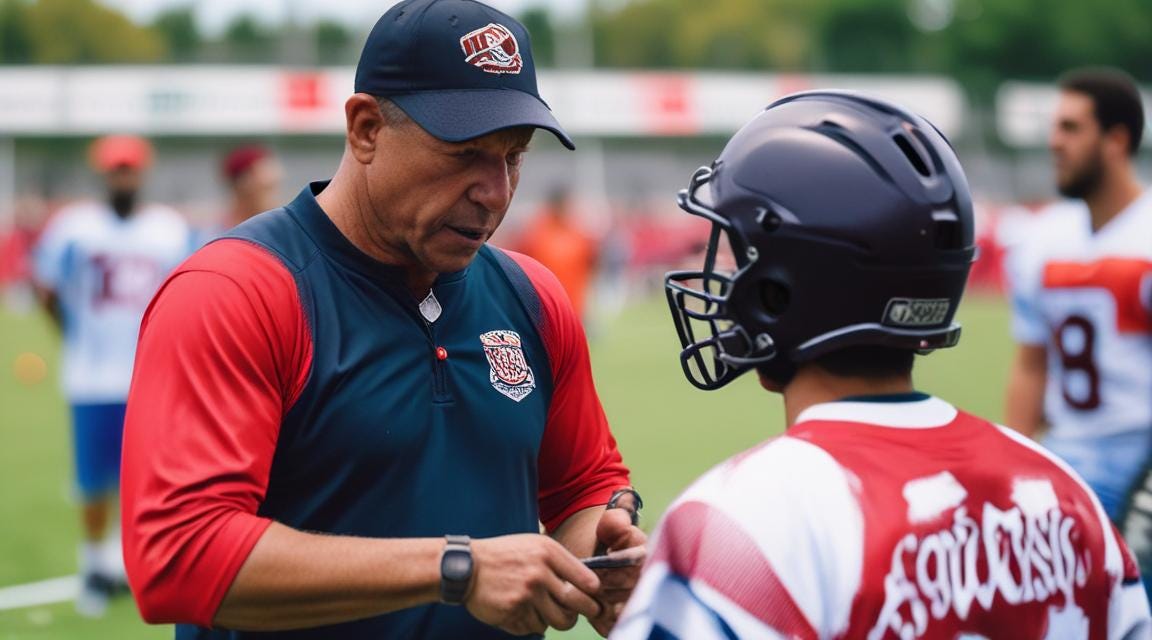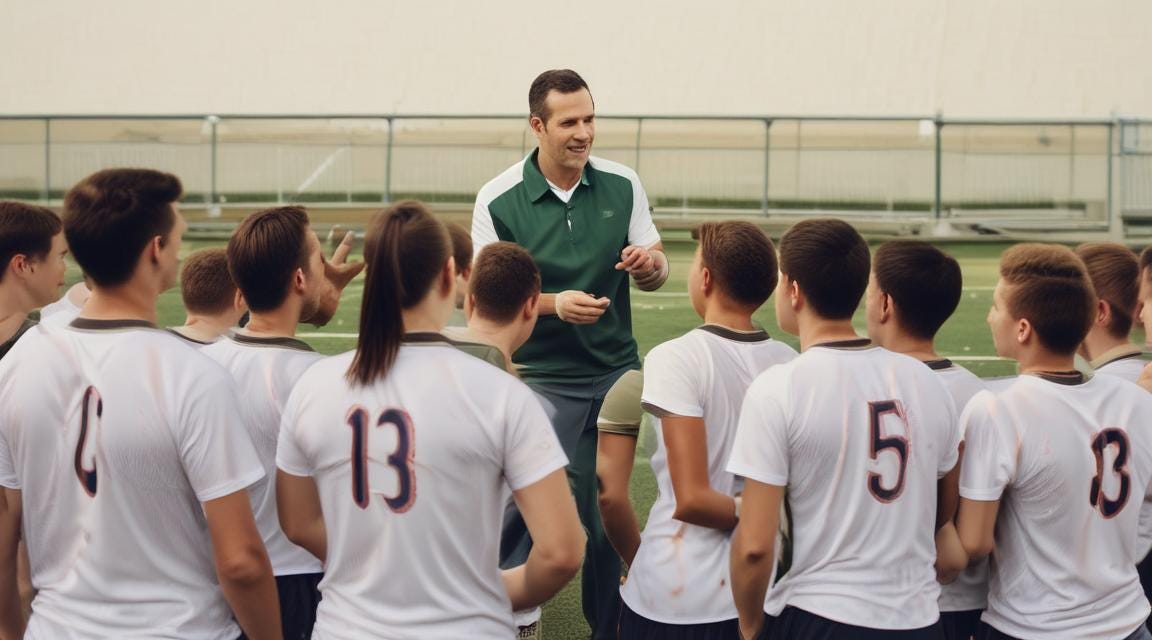What We’re Discussing In This Issue
A Message From Jim and Jason.
Spotlight: Suicide Prevention Month
The Reality Check: How Many Young Athletes are Considering Self-Harm?
The Deep Dive: Examining Some of the Contributing Factors.
The Toolbox: Fostering Open Communication
Game-Changing Quote: Elevate Your Coaching with this Week's Wisdom
Champions of Change: A Coach's Lifesaving Embrace (Based on a True Story)
The Joy of the Game: Keeping the Fun Alive
A Message From Jim and Jason
Coaches
We're thrilled to launch a newsletter dedicated to those who envision youth sports as more than just a game. We're coaches, parents, and mentors who share your belief in the transformative power of sports to develop not only athletes but also resilient, compassionate leaders.
Let's face it. The current state of youth sports isn't working. Despite the billions invested, the mental health crisis among young athletes is escalating. We see the burnout, the anxiety, the pressure – and we refuse to accept it as the norm. You're not alone.
This newsletter is our commitment to YOU. Each month, we'll tackle tough topics head-on, provide actionable strategies, and share stories of coaches making a difference. We'll validate your concerns, educate you on the root causes, and empower you to create positive change.
This month's focus: Suicide Prevention. It's a heavy topic, but one that demands our attention. By fostering a culture of open communication and support, we can save lives. We'll provide resources and guidance to help you identify the warning signs and create a safe space for your athletes.
This is more than a newsletter; it's a movement. We're building a community of coaches who are rewriting the playbook to cultivate leadership in athletes, parents, and coaches. By engaging all stakeholders in the youth sports journey, we aim to develop exceptional leaders both in and out of sports, ensuring growth and leadership across all seasons of life.
Ready to change the game? Let's do this together.
Not your thing? No hard feelings. Click unsubscribe at the bottom of the newsletter.
With unwavering support,
Jim & Jason
Spotlight: Suicide Prevention Month
The world of sports is defined by the pop of a ball hitting a glove, the cheers of a crowd, and the thrill of victory. But beneath this surface lies a silent struggle – a battle fought in the hearts and minds of our young athletes. This battle is personal for me; it claimed the life of my father, my first coach, the man who ignited my passion for sports.
At 17, my world crumbled with his loss by suicide. Amidst despair, a coach emerged who made time for me. He didn't try to fix me but listened, showing me I wasn't alone.
His unwavering belief became a lifeline in my darkest hours, teaching me the power of human connection. Today, as a coach, I see my athletes not just as players but as young people navigating life's complexities. I pledge to break down mental health stigma and create a culture of openness.
Will you join me? Sometimes, all it takes is a listening ear, a reassuring presence, a reminder that someone cares. Together, we can rewrite the narrative and save lives.
Jason Holzer
Two Simple Steps We Coaches Can Take to Help Prevent Suicide:
Create a Safe Space: Encourage open conversations about mental health.
Check In Regularly: Ask your athletes how they're really doing.
The Reality Check
Ever heard whispers that the mental health crisis in youth sports is exaggerated or overblown? In today's world of "anything goes," it's easy to dismiss these concerns. But let's set the record straight: your instincts are spot on. The pressure cooker of youth sports is taking a toll, and the evidence is undeniable.
Consider these alarming statistics:
The CDC reports:
Suicide rates among youth aged 10-24 increased by a staggering 57% between 2007 and 2018.
Mental health-related emergency room visits for children aged 5-17 increased by 24% between 2019 and 2021.
The National Institute of Mental Health (NIMH) states:
Suicide is the second leading cause of death among individuals aged 10-24.
Approximately 1 in 5 youth (aged 3-17) experience a mental, emotional, developmental, or behavioral disorder.
Research specific to young athletes reveals:
A study published in Pediatrics: Young athletes are twice as likely to experience depression and anxiety compared to their non-athlete peers.
The British Journal of Sports Medicine found: 35% of elite young athletes experience symptoms of anxiety and depression.
A survey by the NCAA showed that 30% of student-athletes reported feeling so depressed that it was difficult to function.
Beyond the numbers, there are countless stories and studies that illuminate this crisis.
A heartbreaking article in The Atlantic titled "High School Athletes are Struggling with Mental Illness" delves into the tragic consequences of untreated mental health issues in youth sports.
The Harvard Journal for Sports and Entertainment piece called "The Anxious Athlete: Mental Health and Sports’ Duty and Advantage to Protect" explores the pressures young athletes face and the lack of support systems in place.
The blog post "Nurturing Mental Health in Youth Sports" on the Fight For Children website (https://fightforchildren.org/mental-health-in-youth-sports-blog/) discusses the pressures of youth sports and emphasizes the importance of prioritizing mental well-being alongside physical development.
The relentless pressure to perform, the constant scrutiny of social media, the unrealistic expectations... it's a recipe for emotional turmoil.
As coaches, we're in the trenches. We witness the withdrawn player, the inexplicable drop in performance, the raw emotions bubbling to the surface. We hear the quiet anxieties and the self-doubt. These aren't isolated incidents. They're symptoms of a systemic problem that's crying out for our attention.
We can see that it isn't overblown. So what’s causing it?
Be sure to click here to check out our podcast episode where our guest Leslie Weirich shares her story of losing her son to suicide while he was in college playing football.
The Deep Dive: Understanding Mental Health in Youth Sports
To truly understand the mental health struggles our young athletes face, we need to look beyond the surface. It's not just about the game itself; it's a whole mix of things – physical changes, the pressure to win, and even what's going on with their friends and family. If we only focus on one piece of the puzzle, we're gonna miss the big picture. So let's break it down:
Growing Pains: Adolescence is tough. Add in intense training and high expectations, and it's no wonder we see stress, burnout, and even injuries. Young minds are particularly vulnerable to the long-term impacts of stress.
The Pressure Cooker: The drive to succeed can become a heavy burden. Fear of failure, self-doubt, and the pressure to define oneself solely through sports can lead to anxiety and depression.
The Team (and Beyond): The influence of coaches, parents, and peers can be both positive and negative. A supportive environment can be a lifeline, while negativity can intensify mental health challenges.
So, what can we do about it?
We can't just sit on the sidelines and hope it gets better. We need to tackle these issues head-on:
Build a Team They Can Trust: Create a safe space where athletes know it's okay to talk about their feelings, not just their performance. Set realistic goals, celebrate their effort, and show them that their worth isn't tied to the scoreboard.
Be on the Lookout: Learn the signs of mental distress. Is a usually outgoing kid suddenly withdrawn? Has their performance taken a nosedive? Trust your instincts and reach out.
Get Everyone on Board: Educate parents about the importance of supporting their kids' mental health. Work with other coaches to create a healthier, more supportive youth sports culture.
This September, let's go beyond awareness and take real action. By tackling the root causes of mental health challenges in youth sports, we're not just creating better athletes, we're raising resilient, well-rounded young people who are ready to face any season of life ahead of them.
References: Click here
The Toolbox: Fostering Open Communication
We've explored the many factors impacting our athletes' mental health. Now, let's translate understanding into action. Recognizing the signs of distress and creating a supportive environment can be the difference between a young athlete struggling in silence and getting the help they need.
Here's a deeper look at how to foster open communication with your athletes:
1. Create a safe space:
Set the tone early on: At the beginning of the season, explicitly address the importance of mental well-being and let your athletes know that it's okay to not be okay. Emphasize that you're there to support them, not just as athletes but as individuals.
Normalize conversations about feelings: Incorporate discussions about emotions and mental health into your team culture. Encourage athletes to share their experiences and challenges openly.
Lead by example: Share your own experiences with stress or anxiety. This vulnerability can help athletes feel more comfortable opening up.
2. Check in regularly:
Find time to check in: Dedicate time for individual conversations with each athlete throughout the season. Take 5 minutes either before or after practice to check in and see how your players are doing. Sometimes kids just need to know someone cares. These check-ins provide a private and safe space for them to express any concerns they may have.
Ask open-ended questions: Avoid yes-or-no questions and instead encourage athletes to elaborate on their feelings and experiences. "How are you feeling about the upcoming game?" or "Are you experiencing any challenges that feel overwhelming at school, home or here?" can be good conversation starters.
Actively listen: Pay close attention to what your athletes are saying, both verbally and nonverbally. Make eye contact, nod your head, and paraphrase their words to show that you're truly engaged.
3. Be approachable:
Be present and accessible: Make an effort to be visible and available to your athletes, both during practices and games and outside of scheduled team activities.
Create opportunities for informal interactions: Organize team outings, social events, or casual gatherings where athletes can connect with you and each other in a relaxed setting.
Use technology to your advantage: Consider using communication tools like group chats or messaging apps to stay connected with your athletes and provide an additional avenue for them to reach out if needed. For child safety, keep parents and caregivers in the loop about any group message or messaging app.
Example: Keeping Track of Check-ins
I've found that using a simple spreadsheet or notebook to track my one-on-one conversations with athletes is incredibly helpful. I include columns for the date, the athlete's name, key points from our discussion, and any follow-up actions I need to take. This system helps me stay organized, remember important details, and ensure that I'm connecting with each athlete on a regular basis.
Click here to see an example of a Check-In Spreadsheet, then simply make a copy of this spreadsheet to use to help you track your check ins.
A Personal Story
One season, I noticed that one of my star players seemed unusually withdrawn and quiet. His performance on the court was suffering, and he wasn't interacting with his teammates as much as usual. During a one-on-one check-in, I gently asked him how he was feeling. At first, he hesitated, but then he opened up about the immense pressure he was feeling to perform well and meet his parents' expectations. We talked about healthy ways to manage stress and anxiety, and I encouraged him to prioritize his well-being over his performance. In the weeks that followed, I saw a noticeable change in him. He seemed more relaxed, his performance improved, and he started to reconnect with his teammates.
This experience reinforced for me the importance of fostering open communication and creating a safe space for athletes to express their feelings. By taking the time to truly connect with my athletes on an individual level, I was able to identify a problem early on and provide the support my player needed to thrive, both in and out of sports.
Let's change the game, one athlete at a time.
Game-Changing Quote: Elevate Your Coaching with this Week's Wisdom
"The greatest victories in youth sports aren't measured on the scoreboard, but in the hearts and minds of the young athletes."
Why we like this quote: This quote nails it – it's not about the scoreboard, it's about the things that really stick with kids. It's about them growing as people, learning life lessons, making friends that'll last, and gaining the confidence to tackle anything life throws their way. Sure, winning's great, but it's those other things that'll shape them into the adults they'll become. That's what matters most in the long run.
Champions of Change: A Coach's Lifesaving Embrace (Based on a True Story)
The roar of the crowd, the thud of the ball against cleats, the thrill of a perfectly executed pass—it was all part of the high school soccer season's rhythm. But for one player, the cheers masked a silent struggle. The pressure to perform, the constant scrutiny, the weight of expectations—it had become an unbearable burden.
One afternoon, after practice had ended and the field fell quiet, he found the courage to approach his coach. Tears welled up in his eyes as he spoke, his voice trembling. The darkness that had been swirling within him poured out—the anxiety, the depression, the thoughts he'd never dared voice aloud. The words hung heavy in the air, "I... I don't want to be here anymore."
His coach, a woman known for her tough love and unwavering dedication, responded with something unexpected: a gentle touch, a warm embrace, and a quiet, "I hear you. You're not alone."
In that moment, something shifted. The young athlete felt seen, heard, and most importantly, safe. His coach didn't offer empty platitudes or brush off his pain. Instead, she mobilized a network of support—the school counselor, the athlete's parents—ensuring he received the professional help he desperately needed.
The road to recovery was long and winding, filled with setbacks and moments of doubt. But through it all, his coach remained a constant, offering unwavering support, a listening ear, and a safe harbor in the storm.
Today, that athlete is thriving, a testament to the power of human connection and the transformative impact a caring coach can have. He credits his coach with saving his life, not just by connecting her with professional help, but by creating a space where he felt safe enough to share his darkest thoughts.
Conclusion
This story, based on true events, serves as a poignant reminder: coaches, you have the power to make a profound difference. By prioritizing mental health and fostering a culture of support, you can empower young people to face their demons, find their strength, and choose life. You are not just coaches; you are lifelines.
The Joy of the Game: Keeping the Fun Alive
A friendly reminder of why sports are so great… Enjoy!










